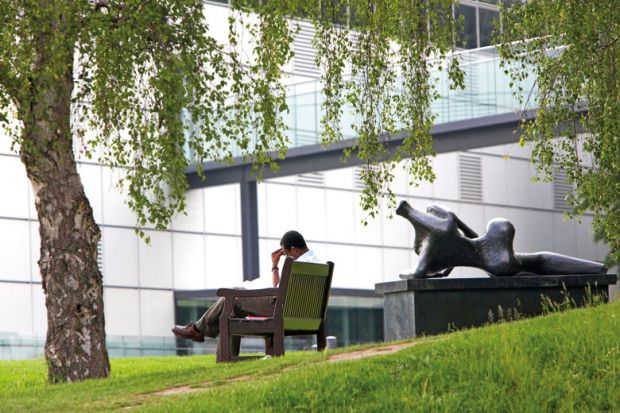Browse the full list of the world's top 150 universities under 50 years old
The University of East Anglia was born on 29 September 1963. The Beatles were at number one with She Loves You, Harold Macmillan was still the UK’s prime minister, and John F. Kennedy was still the US president.
In 1963, Frank Thistlethwaite, UEA’s founding vice-chancellor, opened the university to the first cohort of students of biological science (my spiritual and research home) and English studies. For those first students, the Sir Denys Lasdun ziggurats that have come to help physically define UEA were still a few years away.
The Beatles, Kennedy, Macmillan. It all feels like a world away now. Being a “young” university brings many challenges but it also brings with it the freedom to do things differently and to break the mould. UEA has always had that tradition. Our motto is “Do Different” with good reason.
Thistlethwaite was a champion of interdisciplinary studies and of a university with a global as well as a regional outlook. In 1963, that was far-sighted and innovative. But what seemed bold and pioneering then does look pretty much like the norm today. That legacy, however, is a strong one for us to continue to build on.
As a result of that founding UEA spirit, over the past 50 years we have gone on to break new ground in disciplines such as environmental science, climate research, international development and creative writing. Those achievements no doubt contributed to UEA’s 10th place in the inaugural Times Higher Education 100 Under 50 ranking of universities.
The first challenge for us is that UEA has matured. We are no longer under 50 and have perhaps entered a youngish middle age. We are definitely no longer new. There are plenty of newer entrants to the higher education market. And there are plenty of older institutions with more capital to burn, both in terms of money and reputation, than we have.
As a relative newcomer to higher education, we now have just over 100,000 alumni, and they have gone out into the world with that UEA spirit and their affection for their alma mater continues to make them very special ambassadors for us. We need to build on that.
Claim a free copy of the full 150 Under 50 Rankings 2016 digital supplement
We have to keep innovating and we cannot rest on our laurels. As a relatively young university we blazed a trail but we need to keep doing so. We still have plenty to prove and I suspect that our youth as an institution helps to keep us on our toes. The worst thing that any university can do is become complacent.
Among our major strengths are our campus, our academic and support staff, and the wider community that continues to make UEA special. Our student experience is consistently excellent and we need to make sure that it stays that way. To do that will mean investing in our staff, investing in our campus and increasing our research power.
The second challenge of being a relatively young university is that there is perhaps a reputational lag. We know that we are in the top 50 in the world for research citations but we also know that our reputation for research is not nearly as strong as it could be. This is a perception gap that younger universities need to work hard to close. Older universities do have a much longer story to tell and that is reflected in their reputation. In that regard, perhaps longevity helps?
Third, we need to make the most of redefining ourselves in a more volatile and uncertain world. Our new vision for the UEA in 2030 sets out a framework for making sure that we are fit for the future. There is one thing that I am certain of. We need to look up and out and avoid the temptation to just be focused on ourselves.
To help meet our future challenges, we plan to invest £300 million in our campus to ensure that we have the right facilities for research and learning, to increase our academic and professional services staff, expand student numbers and work with strategic partners to increase our reach and our research power internationally.
As a university, our mission is to help the world meet the challenges that face us all. We will do this by working with partners such as the internationally renowned bioscience institutes on the Norwich Research Park that make us a centre of excellence for research into food, diet and health, and our international partners. Only by pooling our collective strengths will we succeed.
David Richardson
Vice-chancellor, University of East Anglia
POSTSCRIPT:
Print headline: Looking up and out
Register to continue
Why register?
- Registration is free and only takes a moment
- Once registered, you can read 3 articles a month
- Sign up for our newsletter
Subscribe
Or subscribe for unlimited access to:
- Unlimited access to news, views, insights & reviews
- Digital editions
- Digital access to THE’s university and college rankings analysis
Already registered or a current subscriber? Login









